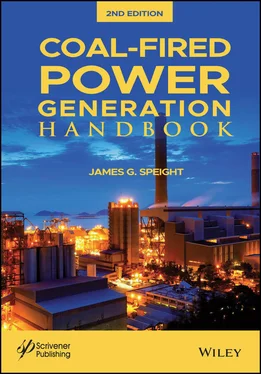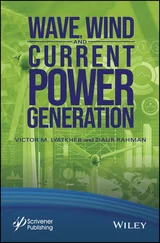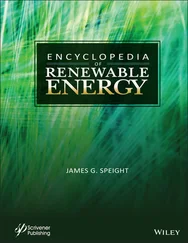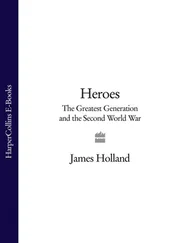Thus, after coal is mined it generally goes through a process known as preparation or coal cleaning to (i) remove the impurities in order to boost the heat content of the coal and thereby improve power plant capacity, which also reduces maintenance costs at the power plant and extends plant life, and (ii) to reduce potential air pollutants, especially sulfur dioxide – the extent to which sulfur dioxide emissions can be reduced varies, depending upon the amount of sulfur in the coal and the form of its occurrence.
Briefly, the grade of a coal establishes its economic value for a specific end use. Grade of coal refers to the amount of mineral matter that is present in the coal and is a measure of coal quality. Sulfur content, ash fusion temperature (measurement of the behavior of ash at high temperatures), and quantity of trace elements in coal are also used to grade coal. Although formal classification systems have not been developed around grade of coal, grade is important to the coal user.
Coal preparation (coal cleaning) is the means by which impurities such as sulfur, ash, and rock are removed from coal to upgrade its value (Speight, 2013). In the process, the undesirable material is removed from the run-of-mine (ROM) coal by employing separation processes which are able to differentiate between the physical and surface properties of the coal and the impurities. The result is a relatively clean uniform coal product.
The energy content of coal is related to its rank (degree of coalification) ( Table 3.2) which is influenced by the content of nonfuel components (e.g., minerals and moisture) (Speight, 2013). Thus, a primary objective of coal cleaning is to maximize the recovery of the heat value of the coal, consistent with achieving standard specifications for mineral matter content (as mineral ash), moisture content, and sulfur content.
Furthermore, since transportation costs are usually charged on a ton-per-mile basis (which does not distinguish between coal substance and moisture content), it is preferential to remove as much as possible of the extraneous mineral matter and water prior to shipping thereby reducing transportation costs for an “inferior” grade of coal and providing a higher energy material to the consumer.
Table 3.2 Typical properties of different rank coals (Speight, 2013).
| Coal type |
Carbon (%) |
Hydrogen (%) |
Limits of volatile matter (%) |
Fixed carbon (%) |
Calorific value (Btu/lb) |
| Lignites |
73–78 |
5.2–5.6 |
45–50 |
50–55 |
<8,300 |
| Subbituminous |
78–82.5 |
5.2–5.6 |
40–45 |
55–60 |
8,300–11,500 |
| High-volatile bituminous |
82.5–87 |
5.0–5.6 |
30–40 |
60–70 |
11,500–14,000 |
| Medium-volatile bituminous |
87–92 |
4.6–5.2 |
20–30 |
70–80 |
>14,000 |
| Low-volatile bituminous |
91–92 |
4.2–4.6 |
15–20 |
80–85 |
>14,000 |
| Anthracite |
95–98 |
2.9–3.8 |
5–10 |
91–95 |
>14,000 |
In fact, long-range transportation of lignite, more than one-third of which consists of water, can more than triple the initial mine-mouth costs calculated on an energy basis. There may, however, be some trade-off in transportation costs if the low-rank coal is sufficiently low in sulfur which, in turn, means a lower cost in terms of stack gas clean-up (Nowacki, 1980).
The need for coal cleaning can be reduced by choice of suitable mining methods, many mines include the methods by which oversize coal is reduced in size but the cleaning of run-of-mine coal is, more often than not, a separate operation which is performed as a surface operation that is usually close to the mine-mouth. However, the term coal preparation includes, by definition, not only sizing (i.e., crushing and breaking) methods but also all of the handling and treatment methods that are required to prepare the coal for the market.
Thus, by providing a higher concentration of heat in the fuel (lower mineral matter and moisture content), the associated costs of transportation, handling, crushing, pulverizing and residual waste (fly ash) disposal in the electricity generation are reduced because fewer weight units per kilo-watt hour generation will be required.
Coal preparation processes are categorized as either physical cleaning or chemical cleaning . Physical coal cleaning processes, the mechanical separation of coal from its contaminants using differences in density, are by far the major processes in use in modern coal-cleaning plants. Physical coal cleaning techniques take advantage of the differences in specific gravity of the coal and its impurities. Hydrocyclones and gravity concentration devices are examples of such systems. When coal is finely ground, physical processes that take advantage of the surface properties of the coal materials can be used. For example, froth flotation exploits the hydrophilic surface characteristics of mineral impurities and the hydrophobic nature of coal particles to achieve separation.
Chemical coal cleaning processes are currently being developed, but their performance and cost are undetermined at this time. For example, some of the sulfur in coal is actually chemically connected to the carbon backbone of coal instead of existing as separate particles. Several process have been tested to mix the coal with chemicals that break the sulfur away from the coal backbone but most of these processes have proven too expensive and have not been applied to commercial coal cleaning operations (Speight, 2013).
The direct objectives of coal-cleaning practices are reduction (within predetermined limits) of size, moisture, ash, as well as sulfur (Williams, 1981; Couch, 1991). However, coal properties have a direct bearing not only on whether but also on how coal should be cleaned. Indeed, coal rank (rank being a complex property that is descriptive of the nature of the coal and its properties) ( Chapters 2, 5, 6) can, and usually does, play an important role in determining the feasibility and the extent of cleaning. Thus, the type of coal beneficiation technology and the extent of beneficiation depend mostly on the type of coal, the means of mining, and the clean coal utilization.
Run-of-mine (ROM) coal has no size definition and consists of pieces ranging from fine dust to lumps as large as 2 feet (0.6 meter) square, or larger depending on the rank of coal (Baafi and Ramani, 1979). It is often wet and may be contaminated with rock and/or clay; as such, the coal is unsuitable for commercial use. At best, the coal seams being worked may be relatively thick, without faults, and uniform, free of associated rock partings, and dry. In such cases the coal may require only some breaking or crushing and screening to produce a pure coal.
Mineral matter content ranges from three to 60% (mineral ash) at different mines. Most of the ash is introduced for the roof or bottom of the mine or from partings (small seams of slate) in the coal seam. This mineral matter (extraneous ash) is heavier than 1.80 specific gravity; the remaining mineral matter is inherent in the coal. The density of coal increases with the amount of mineral matter ash present.
The moisture content of the coal is also of two types. The surface moisture, that which was introduced after the coal was broken loose from the seam, is the easier to remove. This moisture is introduced by exposure to air, wet mining conditions, rainfall (in stockpiles), and water sprays. The remaining moisture ( bed moisture , cellular moisture , inherent moisture ) can be removed only by coking or combustion. This moisture was included during formation of the coal.
Читать дальше












